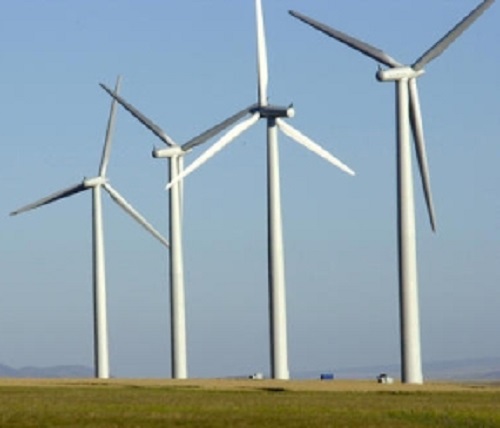Energy
How ‘Green’ projects are looting the treasury

From the Frontier Centre for Public Policy
All that money is wasted. Wind and solar and the various battery projects have not managed to support the electrical grid in any substantial way, hovering, on average, around 4 percent.
The most egregious theft of collective wealth and well-being — and it is flat-out theft — is the churn on “alternative” forms of energy production. Senator Tommy Tuberville of Alabama said last week in an interview with Steve Bannon that the U.S. has spent some $7 trillion over budget in the last three years, and 25 percent of that went to “climate change” projects. They are all like Solyndra, massively subsidized and within a decade, massive failures. “The investors take a tax loss,” said Tuberville, “then move onto the next effort where they again loot the public.” This is salted through all the investment banks, retirement accounts. It represents all putative growth.
In June of 2023, the Department of Energy admitted that it had allocated $1.3 trillion for “clean energy” investment support since 2020, and that spending rose 25 percent from 2021-23. This is a fraction of what was really spent. Further, this money is not only based in debt, thus raising inflation, but it is also raising energy prices. It is the principal reason that almost 25 percent of us, according to economist Peter St. Onge, have been forced to choose between heat and food this winter.
What a choice.
$1,750,000,000, in an annual gift to the rich. The World Economic Forum projects that climate spending in the U.S. will triple over the next ten years. Biden’s “climate” budget is $5.7 trillion. Triple that to $20 trillion. No wonder the market is booming. The U.S. has pledged another half a trillion in “low carbon electricity” under this year’s Paris Climate Accord. And further:
- Among all measures tracked since 2020, direct incentives for manufacturers aimed at bolstering domestic manufacturing of “clean” energy now total to around $90 billion.
- Since the start of the global energy crisis, governments have also allocated $900 billion to short-term consumer affordability measures, additional to pre-existing support programs and subsidies. Around 30 percent of this “affordability” spending has been announced in the past six months, and despite calls to better target households and industries most in need, only 25 percent of affordability measures are targeted towards low-income households and most-impacted industries.
Much of this last $900 billion is direct subsidy to the wealthy in annual subsidies for clean energy. This is again, annual subsidy, so look at the last twenty years. President Obama started this program, therefore, we are looking at a $10 – $ 20 trillion gift to the rich since the Lightbringer took office. What is not counted in these budgets are the losses that accrue from the failure of “green energy” projects, which is the taxpayer’s loss.
Last year, investors in Spain’s green energy collapse took the government to court to claw back subsidies from a dead industry in a country with a debt 400 percent larger than GDP. No wonder millions on the street want to outlaw socialism. As is clear from Spain, when the government runs out of money the first thing to go is the subsidy to green energy, after which the enterprise fails immediately.
In my neck of the Canadian woods, you can install a solar system for $20,000, and get a 25 percent subsidy, as does the installer whose business the government created via “free” “investment.” I live in a rain forest. Which means solar is not available during winter rains and not needed during the summers. Recently everyone with a few extra bucks has taken up the government offer to install heat pumps, also subsidized by between 50 percent and 75 percent. Rain forests mean hydro power, which is essentially, greenhouse-gas-free, and the most inexpensive “fuel,” but an almost-free heat pump? Again win/win for the upper-middle-class because no one in Canada’s increasingly massive working class can afford it.
This model was invented by politicians in power. The first person to notice it was Peter Schweizer; in Throw Them All Out, he details the billionaire investors who funded Obama and who were cashed out via various solar and wind projects. Hundreds of billions of dollars went missing on Obama’s various “clean energy” projects.
This year, every government department is “investing” in clean energy, vis, a quick Google search, will show. Pages and pages of boastful press releases follow. Every agency is in on the boondoggle. NOAA, the National Oceanic and Atmospheric Administration, and the U.S. Patent and Trade Mark Office have signed a collaborative agreement to advance climate technology. Putting aside the fact that “climate change” is neither imminent nor dangerous, the government should not be creating patents. Innovation should be carried out by the private market, where there are controls.
As we discovered during Covid, government patents on both the virus and the vaccine were not subjected to court challenge, double blind testing, or feasibility. There is no number attached to NOAA’s “initiative,” but this is representative of ten thousand such projects salted through every government bureau. All that money is wasted. Wind and solar and the various battery projects have not managed to support the electrical grid in any substantial way, hovering, on average, around 4 percent. Despite this mind-boggling waste of money, in September last year former New York City mayor Michael Bloomberg pledged another $500 billion to shutter the equivalent of 40 percent total electricity use of nine states, including California, Florida, New York, Illinois and Texas.
What has been the result of trillions of public money shunted into “clean” “green” “energy” on the actual energy grid? Robert Bryce, an acknowledged expert, shows that it is failing. A speech he gave at the winter meeting of the National Association of Regulatory Utility Commissioners showed astonishing, across the-board failure in every metric you can imagine.
“Climate Policy” is considered the most significant risk. As Bryce describes, “green energy” has meant Europe is deindustrializing, Ford lost $64,731 for every EV it sold, and the IEA states that global coal use will hit another new record of 8.5 billion tons. Coal use increased 35 percent in last summer’s heat wave. Wind dropped by 21 percent.
Climate policy breaks everything. It breaks communities, it encourages widespread theft of public money, it starves productive work and manufacturing, it has punched down on the less advantaged, and it is destroying the fabric of our lives. And for what?
First published in thepipeline.org, March 24, 2024.
Elizabeth Nickson is a Senior Fellow at the Frontier Centre for Public Policy.
Energy
The Trickster Politics of the Tanker Ban are Hiding a Much Bigger Reckoning for B.C.

From Energy Now
By Stewart Muir
For years, a conservation NGO supported by major foreign foundations has taken on the guise of Indigenous governance authority on British Columbia’s north coast. Meanwhile, rights-holding First Nations with an economic agenda are reshaping the region, yet their equal weight is overlooked. A clash of values has resulted.
For more than a decade, British Columbians have been told — mostly by well-meaning journalists and various pressure groups — that an organization called Coastal First Nations speaks with authority for the entire coast. The name sounds official. It sounds governmental. It sounds like a coalition of Indigenous governments with jurisdiction over marine waters.
It isn’t any of those things.
Coastal First Nations (CFN) is a non-governmental organization, incorporated under the BC Societies Act as The Great Bear Initiative Society. It doesn’t hold Indigenous rights or title. It has no legislated role to provide benefits or services to First Nations members. It has no jurisdiction over shipping, marine safety, forestry, fisheries, energy development, or environmental regulation. Yet its statements are frequently treated as if they carry the weight of sovereign authority.
It’s time to say out loud what many leaders — municipal, Indigenous, and industry — already know: CFN is an advocacy group, not a government. Case in point, a recent news story with the following lede: “B.C.’s Coastal First Nations say they will use ‘every tool in their toolbox’ to keep oil tankers out of the northern coastal waters.” A spokesperson claimed to represent “the Rights and Title Holders of the Central and North Coast and Haida Gwaii,” yet notwithstanding the rights of any individual First Nation, CFN does not hold any formal authority.
Here’s why this matters. The truth is, Alberta has already struck its grand bargain with the rest of Canada. Now it’s time to confront the uncomfortable truth that the country is still one bargain short of a functioning national deal.
In 2026, with Canadians increasingly alert to who is shaping national conversations, there is a reasonable expectation that debates affecting our economic future should be led and conducted by Canadians — not by foreign foundations, not by out-of-country campaign strategists, and not by NGOs built to advance someone else’s policy objectives.
Where the confusion came from
CFN’s rise in public visibility traces back to the “Great Bear Rainforest” era, when U.S. philanthropic foundations poured large sums of money into environmental campaigns in British Columbia. A Senate of Canada committee document notes that the Gordon & Betty Moore Foundation alone provided approximately $25 million directly to Coastal First Nations, delivered as twenty-five nearly $1 million installments.
CFN also played a central role in the Great Bear Rainforest negotiations, which were financed by a coalition of foreign philanthropies including the Packard Foundation, Hewlett Foundation, Wilburforce Foundation, Rockefeller Brothers Fund, Nature Conservancy/Nature United, and Tides Canada Foundation. These foundations collectively contributed tens of millions of dollars to the “conservation financing” model that anchored CFN’s operating environment.
This history isn’t speculative. It’s well documented in foundation reports, Canadian Parliamentary evidence, and the publicly disclosed financial architecture behind the Great Bear Rainforest. For a generation, well-funded U.S. environmental campaigns have worked to make Canadians afraid of their own shadow by seeding doubt, stoking paralysis, and teaching a resource nation to second-guess the very wealth that built it.
Between 2010 and 2018, an independent forensic accounting review by Deloitte Forensic (backed by the Alberta government) found that foreign foundations provided roughly $788.1 million in grants for Canadian environmental initiatives. The largest single category — by a wide margin — was marine-based initiatives, totalling $297.2 million. In Deloitte’s categorization, “marine-based” overwhelmingly refers to coastal campaigns: Great Bear Rainforest–related advocacy, anti-tanker/shipping activism, marine-use regulation campaigns, marine ecological programs, and other coastal political work.

Land-based initiatives were the second-largest category ($191 million), followed by wildlife preservation ($173 million).
The forensic review also showed that of the $427.2 million that physically entered Canada, 82% — approximately $350.3 million — was spent in British Columbia, with the dominant share directed specifically toward coastal and marine initiatives.
Taken together, these findings confirm that foreign-funded environmental activity in Canada has been geographically concentrated in British Columbia and thematically concentrated on the coast – exactly the domain where CFN has been positioned as a public-facing authority.
The real authority lies with the nations themselves
If British Columbians want to understand who truly governs the coast, they should look to the Indigenous governments that hold rights, title, citizens, and accountability — not NGOs that comment from the sidelines. That means not overlooking:
- Haisla Nation, leaders of Cedar LNG
- Nisga’a Nation, co-developers of Ksi Lisims LNG
- Gitxaala Nation, asserting legal and territorial authority
- Kitselas and Kitsumkalum, both shaping regional development
These governments are also coastal First Nations. They negotiate major economic partnerships, steward lands and waters, and make decisions grounded in their own legal orders. Moreover, representation is the key measure of accountability in a democracy: First Nations governing councils are elected by their members. The CFN is not elected. The nations are accountable to their own people — not to U.S. philanthropies or to the strategic objectives of foreign-backed environmental campaigns.
The Haisla Nation once belonged to CFN, but quit in protest in 2012 when the body opposed LNG. The Haisla council went on to fully embrace economic development via liquefied natural gas and own the upcoming Cedar LNG project.
Meanwhile, the central and northern coastal regions where CFN has opposed numerous economic opportunities continue to suffer the worst child poverty in British Columbia.
In the delicate politics of the region’s First Nations alliances, relationships are constantly in motion and governed by inviolable traditions of mutual respect. From these threads, it has to be said that the CFN’s strategy of weaving the appearance of unanimity is truly a fabrication. In point of fact, CFN represents just one half of the story. My data source tells the story, by drawing together the latest available economic and demographic information for 216 British Columbia First Nations:
- Status Indian residents of CFN communities on the north coast number 5,484, with a total membership near and far of 20,447.
- The pro-development group noted earlier numbers 5,505 living local out of a total membership of 16,830.
In other words, virtually equal. Hence it’s obvious that any media report citing CFN as the singular authority for local First Nations interests is a misleading one. CFN speaks for only a slice of the North Coast, not the whole, and the numbers make that impossible to ignore.
When a CFN motion opposing responsible resource development was adopted by the Assembly of First Nations (see Dec. 2 news), it was further evidence that the deck is stacked against First Nations that are accountable and position themselves as having broad responsibilities, including but not limited to raising the standard of living of their members.
The future belongs to the nations
The politics of LNG on the North Coast can’t be grasped without staring directly at the tanker ban — not as scripture, but as the political curiosity it has become. Anyone who knows these waters understands it’s mostly theatre: it doesn’t question letting Alaska oil tanker ships transit our exclusive economic zone when we cannot, and it doesn’t touch the real risks coastal people actually worry about. Yet waving it away is naïve. The ban behaves like a trickster spirit in our public life — capricious, emotionally loaded, and capable of turning a routine policy debate into a cultural conflagration with barely a flick of its tail.
This is why Coastal First Nations retain such gravitational pull. For years, the ban has served as the moral architecture of their Great Bear Sea campaign. CFN represents a long-game strategy — build legitimacy, occupy the moral high ground, and shape the destiny of a nation by holding the symbolic centre. Their concerns seem genuine and rooted in lived stewardship – yet were shaped by Madison Avenue minds hired by American philanthropists to affect our politics. But a near equal number of coastal nation residents unified by a different outlook also have skin in the game. They are charting futures grounded in prosperity, environmental care, and sovereignty on their own terms, and their authority is the real thing — born of title, law, and accountability to their own people.
And here is the irony worth heeding: the tanker ban’s pageantry masks a solution. It is dragging into daylight a conversation the province has avoided for decades — a conversation that will soon prove inevitable as court rulings unsettle the very foundation of property rights in British Columbia. This is the hinge that the moment turns on.
Canada cannot resolve its growing national contradictions without moving its energy to global markets. Alberta has already made its grand bargain with the country. Now British Columbia must craft its own — harnessing the prosperity of energy development to discharge political debts and finally settle the title question that has defined the province’s modern era.
Stewart Muir
Economy
What the Data Shows About the New Canada-Alberta Pipeline Opportunity

From Energy Now
By Canada Powered by Women
Canada has entered a new period of energy cooperation, marking one of the biggest shifts in federal–provincial alignment on energy priorities in years.
Last week as Prime Minister Mark Carney and Alberta Premier Danielle Smith signed a memorandum of understanding (MOU) that outlines how both governments will approach a potential pipeline to British Columbia’s coast.
The agreement, which has been described as a “new starting point” after years of tension, lays the groundwork for a privately financed pipeline while also linking this commitment to a broader set of infrastructure priorities across oil and gas, LNG, renewables, critical minerals and electricity transmission.
It also sets out how a privately financed project, moving roughly 300,000 to 400,000 barrels of oil to global markets each day, will be reviewed.
Now that the announcement is behind us, attention has turned to how (or if) a pipeline is going to get built.
Alberta has set out its ambitions, British Columbia has its conditions, and the federal government has its own expectations. Together, these positions are shaping what some are calling a “grand bargain” which will be made up of trade-offs.
Trade-offs are not a new concept for the engaged women that Canada Powered by Women (CPW) represents, as they’ve been showing up in our research for several years now. And anyone who reads us also knows we like to look at what the data says.
According to new polling from the Angus Reid Institute, a clear majority of Canadians support a pipeline, with national backing above 60 per cent. And there’s strong support for the pipeline among those in B.C. This aligns with other emerging data points that show Canadians are looking for practical solutions that strengthen affordability and long-term reliability.
By the numbers:
• 60 per cent of Canadians support the pipeline concept, while 25 per cent oppose it.
• 53 per cent of people support in British Columbia, compared to 37 percent opposed.
• 74 per cent of people in Alberta and Saskatchewan support the pipeline.

Our research shows the same trends.
A large majority (85 per cent) of engaged women agree that building pipelines and refining capacity within the country should be prioritized. They favour policies that will progress stability, affordability and long-term economic opportunity.
A key feature of the MOU is the expectation of Indigenous ownership and benefit sharing, which Alberta and B.C. governments identify as essential, and which aligns with public opinion. As of right now, Indigenous groups remain split on support for a pipeline.
The agreement also signals that changes to the federal Oil Tanker Moratorium Act may need to be considered. The moratorium, in place since 2019, is designed to limit large tanker traffic on the North Coast of B.C. because of navigation risks in narrow channels and the need to protect sensitive coastal ecosystems.
Those in favour of the pipeline point to this as a critical barrier to moving Canadian oil to international markets.
Polling from the Angus Reid Institute shows that 47 per cent of Canadians believe the moratorium could be modified or repealed if stronger safety measures are in place. Again, we come back to trade-offs.
The MOU is a starting point and does not replace consultation, environmental review or provincial alignment. These steps are still required before any project can advance. Taken together, the agreement and the data show broad support for strengthening Canada’s energy options.
This will be an issue that engaged women are no doubt going to watch, and the conversation is likely to move from ideas to discussing what trade-offs can be made to bring this opportunity to life.
-

 Business2 days ago
Business2 days agoCarney’s Toronto cabinet meetings cost $530,000
-

 Artificial Intelligence2 days ago
Artificial Intelligence2 days agoAI is accelerating the porn crisis as kids create, consume explicit deepfake images of classmates
-

 Bruce Dowbiggin2 days ago
Bruce Dowbiggin2 days agoIntegration Or Indignation: Whose Strategy Worked Best Against Trump?
-

 MAiD2 days ago
MAiD2 days ago101-year-old woman chooses assisted suicide — press treats her death as a social good
-

 COVID-191 day ago
COVID-191 day agoCanadian legislator introduces bill to establish ‘Freedom Convoy Recognition Day’ as a holiday
-

 espionage2 days ago
espionage2 days agoDigital messages reportedly allege Chinese police targeted dissident who died suspiciously near Vancouver
-

 International2 days ago
International2 days agoFBI may have finally nabbed the Jan. 6 pipe bomber
-

 COVID-191 day ago
COVID-191 day agoUniversity of Colorado will pay $10 million to staff, students for trying to force them to take COVID shots









